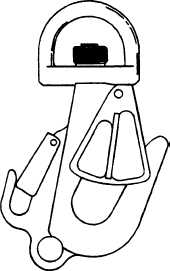b. Place a piece of full-range test paper on
the dampened area. Compare it to the color
standard provided with the paper. The color it
changes to indicates the approximate pH reading
and which specific short-range test paper to use.
c. Place the short-range test paper on the
dampened area. Its color indicates the pH factor
of the affected area.
d. If acid contamination is found, the
assembly must be considered nonrepairable and
scrapped.
e. If alkaline contamination is found, rinse
the assembly in cool, fresh water until a safe read-
ing is obtained. All fabric and webbing must then
be carefully inspected for any sign of deteriora-
tion.
3. Visual inspection. To inspect the rescue
harness, examine the following:
a. Harness webbing for cuts, tears,
fraying, deterioration, and security of stitching.
b. Front pouch and right and left pockets
for cuts, tears, fraying, deterioration, and security
of stitching.
c. Gated D-ring and all other hardware for
corrosion, distortion, sharp edges, security of
attachment, and ease of operation.
d. Hook and pile tape fasteners for
condition and proper mating.
Cleaning
Clean the rescue harness as often as necessary
to remove perspiration stains, dirt, and other
stains that may degrade performance of the
assembly. To clean a rescue harness, proceed as
follows:
1. Wrap all metal fittings in heavy flannel
cloth.
CAUTION
DO NOT SCRUB RESCUE HARNESS.
2. Soak the assembly in cool, fresh water for
2 to 3 hours to loosen any set stains.
3. Drain this water and immerse the harness
in a tub of fresh water (not over 120°F). Gently
agitate by hand.
4. After 5 to 10 minutes of agitating, repeat
step 3.
5. Petroleum and other stubborn stains may
be removed by repeated applications of a mild
soap and water solution. Each application must
be followed by a rinse in cool, fresh water.
239.409
Figure 5-20.—Rescue hook.
6. Hang the rescue harness on a wooden
hanger until dry.
RESCUE HOOK
The rescue hook consists of one large hook,
an adjacent small hook, and ring located at the
bottom of both-hooks. A bearing assembly is
attached to the upper section allowing the hook
to rotate freely about its axis. The large hook
supports 3,000 pounds and is used to hoist
personnel. The smaller hook supports 1,000
pounds and is used to hoist equipment. The ring
at the bottom supports 1,500 pounds and is also
used to hoist miscellaneous equipment. Both
hooks have a spring-loaded latch to prevent
inadvertent release of personnel or equipment.
(See figure 5-20.)
The rescue hook is attached to the hoist cable
and is used to assist rescue personnel in
performing rescue operations from a helicopter.
The rescue hook can hoist personnel and/or
equipment during both sea and land
rescues.
Maintenance
The aircrewman’s responsibility is
maintenance control if equipment
helicopter
to inform
has been
immersed in salt water. Repairs or other actions
required are performed by organizational-level
maintenance or above.
5-20

